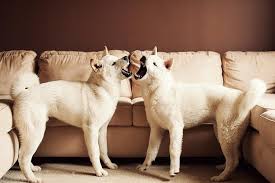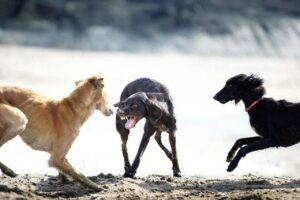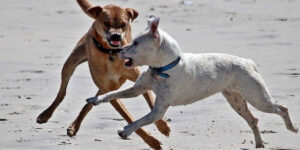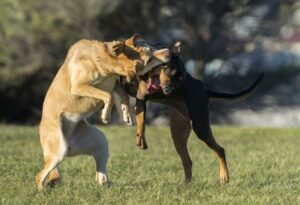Dogs are social animals and can live peacefully with other dogs in the same household, but sometimes conflicts may arise and lead to fighting. This can be stressful and dangerous for both dogs and their human caregivers. This article will discuss some strategies for preventing and how to stop dogs from fighting in the same household.
One essential step is identifying the trigger for the aggressive behavior, such as possessiveness over a toy or food, fear, or something else. Separating the dogs immediately and using a loud noise or physical barrier can help stop a fight in progress.
Training the dogs using obedience classes and positive reinforcement techniques can also help teach them how to behave around other dogs. Provision of adequate exercise and seeking the help of a professional trainer or veterinarian, if necessary, can also help address and modify aggressive behavior.
How to stop dogs from fighting in the same household
If your dogs are fighting in the same household, it is vital to stop the fights and prevent future incidents. Identify what is causing your dogs to fight, as it could be a specific object, person, or location. Once you know the trigger, you can work to remove or avoid it.
Giving each dog space, such as a separate crate or room, can also help reduce the chances of fighting. Always supervise interactions between your dogs to ensure they are not getting into fights, and intervene immediately if you see any signs of aggression.
Training and socializing your dogs can also help them learn appropriate behaviors and how to get along with others. If the fighting persists or you are unsure how to address the problem, consult a veterinarian or a professional trainer for guidance.
Following these steps and working with a professional can help your dogs learn to get along and live peacefully in the same household.

How do you stop dogs fighting that live together?
If your dogs are fighting, it is vital to intervene as quickly and safely as possible to prevent injury to the dogs and you. Here are some steps you can take to try to stop dogs from fighting:
1. Stay calm and try to remain as unemotional as possible. Dogs can sense your emotions and may become more agitated if you are anxious or upset.
2. Try to create a physical barrier between the dogs, such as using a broom, chair, or blanket to separate them.
3. Make a loud noise, such as clapping or shouting, to startle the dogs and interrupt their aggression.
4. Spray the dogs with water from a squirt bottle or hose to interrupt the fight.
5. If the dogs are on leashes, you can try using the leashes to gently but firmly pull the dogs apart.
6. If the dogs are not on leashes, try to grab the hind legs of one of them and lift them off the ground. This can help break the cycle of aggression.
It is important to note that breaking up a dog fight can be dangerous and should only be done if you are physically able to do so. If you cannot intervene safely, it is best to call for professional help.
How do I stop my dog from attacking my other dog?
It is excellent to address aggressive behavior in dogs as soon as possible to prevent injuries and maintain a positive relationship between the dogs. Here are some steps you can take to help stop your dog from attacking your other dog:
1. Identify the trigger: determine what is causing your dog to become aggressive towards the other dog. This could be a particular type of behavior, a specific item, or a particular time of day.
2. Separate the dogs: if the dogs display aggressive behavior toward each other, they must separate until they can address the behavior.
3. Consult a professional: if you are unsure how to address the aggressive behavior, consider seeking the help of a veterinarian, a professional dog trainer, or a behaviorist. These professionals can help you identify the cause of the aggression and develop a plan to address it.
4. Use positive reinforcement: try to reinforce desirable behaviors and ignore or redirect undesirable behaviors. Use rewards like treats or praise to encourage your dog to exhibit non-aggressive behavior towards the other dog.
5. Practice obedience training: training your dog to follow basic commands such as “sit,” “stay,” and “come” can help you better control your dog’s behavior and may help prevent aggressive incidents.
6. Provide proper socialization: exposing your dog to various people, places, and other animals can help prevent aggressive behavior toward unfamiliar dogs.
7. Consider using a muzzle: if your dog is displaying aggressive behavior that cannot be controlled or is at risk of injuring another dog or person, considers using a muzzle as a temporary measure.
Can dogs live together after fighting?

Dogs can live together after fighting, but it is essential to be cautious and take steps to prevent future fights. Suppose the dogs have a history of aggression toward each other. In that case, it may be necessary to keep them separated or to seek the help of a professional trainer or behaviorist to address the issue.
If the fight was minor and the dogs had a strong bond, they may be able to continue living together with no issues. However, if the fight is more severe or the dogs do not have a strong bond, it may be more difficult for them to live together peacefully.
In these cases, monitoring the dogs closely and taking steps to prevent future fights will be necessary. This may involve separating the dogs when they are not supervised, providing each dog with its own space, and training the dogs to behave appropriately around each other.
Ultimately, the success of living together after a fight will depend on the individual dogs and their specific circumstances.
How to discipline a dog after fighting
It’s essential to address any aggressive behavior in a dog as soon as possible to prevent it from becoming a habit. Here are some steps you can take to discipline a dog after a fight:
1. Keep the dog separated from other animals until you can determine the cause of the fight and address any underlying issues.
2. Try to identify the trigger that caused the fight and remove or avoid it in the future.
3. Use positive reinforcement training techniques to teach your alternative dog behaviors to replace aggressive ones.
4. Consider using a muzzle or leash when interacting with other animals to give you more control over your dog’s behavior.
5. Seek the help of a professional dog behaviorist if the aggressive behavior persists or you cannot manage it on your own.
It’s worth noting that disciplining a dog after a fight does not mean punishing the dog. Instead, focus on addressing the underlying causes of the aggressive behavior and teaching your dog more appropriate ways to behave.
What should you not do after a dog fight?
Better to act quickly and calmly in the aftermath of a dog fight to ensure the safety of all involved and to minimize any further stress or injury. Here are some things you should not do after a dog fight:
1. Do not try to physically break up the fight, as you could get bitten or injured.
2. Do not shout or make loud noises, as this could agitate the dogs further and escalate the fight.
3. Do not hit or strike the dogs, as this could cause additional injury and may not be effective in stopping the fight.
4. Do not try to separate the dogs by pulling on their tails or hind legs, as this could cause serious injury.
5. Do not immediately try to reintroduce the dogs after the fight, as this could result in a renewed fight.
Instead, try the following steps to break up a dog fight safely:
1. Stay calm and remain safe from the fighting dogs.
2. Use loud noises or a water spray to distract the dogs and interrupt the fight.
3. Use a barrier such as a blanket or a jacket to separate the dogs.
4. If you cannot safely separate the dogs, call for help or seek assistance from a professional.
Do dogs forgive each other after a fight?

Very possible for dogs to forgive each other after a fight, but it is essential to understand that dogs communicate and resolve conflicts in ways that are different from humans. Dogs often use physical aggression to resolve disputes, and after a fight, they may move on without any further confrontation.
However, it is not uncommon for dogs to continue to display aggressive or dominant behaviors toward each other after a fight, especially if the fight is severe or the underlying cause of the conflict is not addressed.
Instant intervention when dogs are fighting, as fights can be dangerous and can result in serious injuries. If you witness a fight between dogs, it is essential to separate them safely and seek medical attention if necessary.
You need to identify the underlying cause of the conflict and address any issues contributing to the aggression, such as a lack of training, inadequate socialization, or resources. By addressing the root causes of the conflict, you can help prevent future fights and improve the overall relationship between the dogs.
Why my dog keeps attacking my other dog for no reason
There could be various reasons your dog is exhibiting aggressive behavior towards the other dog. It would help if you tried to identify the root cause of the aggression to address the behavior effectively.
One possible reason for aggression between dogs is a lack of socialization. Dogs who have not been exposed to various people, places, and other dogs during the critical socialization period (between 3 and 12 weeks of age) may be more prone to aggressive behavior.
Another possible reason for aggression between dogs is a lack of leadership or structure in the home. Dogs are social animals and need to know their place in the pack hierarchy. If there is no clear leader in the household, dogs may try to assert dominance over each other, leading to aggressive behavior.
It is also possible that certain stimuli or circumstances, such as the presence of food or toys, are triggering aggressive behavior. In these cases, removing the trigger or using positive reinforcement training to teach the dogs alternative behaviors may be helpful.
Finally, be sure if a medical condition or physical discomfort causes aggressive behavior. Suppose you have ruled out the other possible causes, and your dog’s aggressive behavior persists. In that case, a veterinarian must have your dog evaluated to rule out any underlying medical issues.
How do you fix an aggressive dog to other dogs?

If your dog is exhibiting aggressive behavior towards other dogs, it is crucial to address the issue immediately to prevent any incidents or injuries. Here are some steps you can take to help fix your dog’s aggressive behavior:
- Consult a veterinarian or a professional dog trainer to rule out any medical or behavioral issues causing the aggression.
- Begin training your dog using positive reinforcement techniques, such as rewarding good behavior with treats or praise.
- Practice obedience training with your dog, including commands such as “sit,” “stay,” and “come.” This can help you establish yourself as the leader and give you more control when your dog becomes aggressive.
- Gradually introduce your dog to other dogs in controlled settings, such as a park or a training facility, and supervise the interactions closely.
- Use a muzzle when necessary, mainly when introducing your dog to new dogs or when there may be a risk of aggression.
- Avoid confrontational or aggressive behavior towards other dogs, which can escalate and worsen the aggression.
Finally, it can take time and patience to fix aggressive behavior in dogs, and it may require the help of a professional trainer or behaviorist. It is also essential to be consistent and persistent in your training efforts to see lasting results.
Why does my dog keep attacking the same dog?
There could be several reasons why your dog is attacking the same dog. It could be due to fear, territorial behavior, or possibly a previous negative experience with that particular dog. It could also be due to a lack of socialization or training or a medical condition such as pain or discomfort.
Try to consult a veterinarian or a professional dog trainer to determine the root cause of the aggressive behavior and develop a plan to address it. It is vital to intervene and address aggressive behavior as soon as possible, as it can escalate and potentially cause harm to other animals or people.

How to stop jealous dogs from fighting
Jealousy and competition between dogs can lead to fighting, which can be dangerous for dogs and humans. To prevent jealousy-related fights, managing your dogs’ environment and behavior is essential to promote harmony and reduce competition. Here are a few tips:
1. Give each dog enough attention and resources, such as toys and treats.
2. Use positive reinforcement training to teach your dogs to obey commands and respect boundaries.
3. Keep an eye on your dogs when they are together, and intervene if you see signs of tension or aggression.
4. Use separate feeding areas and feeding times for each dog.
5. Avoid playing games that involve competition or dominance, such as tug-of-war.
6. Consider consulting a professional dog trainer or behaviorist if the problem persists.
It’s also important to remember that fighting between dogs can be a severe issue, and it may be necessary to seek professional help to address the root cause of the problem and prevent future fights.
Do dogs get aggressive when jealous?

Dogs can exhibit aggressive behavior when they feel jealous. Jealousy in dogs may be triggered by the attention, affection, or resources given to another animal or person. This behavior may be more likely to occur in particularly possessive or territorial dogs.
In some cases, a dog may become aggressive when they feel threatened by the presence of another animal or person. This aggression may be a way for the dog to assert its dominance or protect what they view as its territory or resources.
Best to pay attention to your dog’s body language and behavior when interacting with other animals or people and to intervene if necessary to prevent any aggressive behavior from escalating.
Why is my dog jealous of the other dog?
Dogs are social animals and can experience various emotions, including jealousy. Jealousy in dogs can be triggered by multiple factors, such as attention from their owners, toys, or other resources. If your dog is showing signs of jealousy, it could be because they feel the other dog is receiving more attention or resources than they are.
It could also be because they feel threatened by the other dog and are trying to protect their territory. To help reduce jealousy in your dog, try to give them equal amounts of attention and resources, and consider providing separate toys or areas for each dog to minimize competition.
Additionally, providing your dog with plenty of mental and physical stimulation through training, exercise, and play can help reduce negative emotions. If your dog’s jealousy is causing severe behavioral problems, it may be a good idea to seek the help of a professional trainer or behaviorist.
Should I let my dogs fight for dominance?

Dogs fighting for dominance are not recommended. Allowing dogs to confront others physically can cause severe injuries and long-term behavioral issues such as aggression and fear.
However, better to establish clear rules and boundaries for your dogs and to provide consistent training and leadership to prevent conflicts and establish a healthy hierarchy.
If you are unsure how to address dominance issues between your dogs, it is best to seek the help of a professional dog trainer to develop a behavior modification plan. It is never appropriate to allow dogs to harm each other to establish dominance physically.
Will muzzles stop dogs from fighting?
Muzzles can be a helpful tool in preventing dogs from biting or fighting, but they should not be relied upon as the sole means of deterring aggression. Muzzles can prevent dogs from biting or lashing out but do not address the underlying causes of aggressive behavior.
You need to identify the triggers for aggressive behavior and address them through training and behavior modification. Additionally, muzzles can be uncomfortable for dogs and may cause them to become more anxious or agitated.
Suppose you use a muzzle to prevent your dog from biting or fighting. In that case, it is better to monitor its behavior and use the muzzle only as a temporary measure while addressing the underlying causes of the aggression. It is also essential to use a properly fitting muzzle to ensure the dog’s comfort and safety.
How to stop dogs from fighting for dominance

To stop dogs from fighting for dominance, it is vital to establish yourself as the pack’s leader and set clear rules and boundaries for the dogs to follow. This can be done through consistent training, setting rules for behavior, and consistently enforcing those rules.
Also, essential to monitor the dogs for any signs of aggression and intervene if necessary. If the dogs are consistently fighting for dominance, they may be required to seek the help of a professional dog trainer or behaviorist to address the issue. It is also essential to ensure that the dogs get enough physical and mental stimulation, as boredom or frustration can often lead to aggressive behaviors.
How to stop aggression in female dogs
There are several ways to help stop aggression in female dogs:
1. Proper socialization: Make sure your dog is properly socialized from a young age to help prevent aggressive behavior towards other dogs and people. This can involve exposing your dog to various environments, people, and animals and teaching them how to behave calmly and appropriately.
2. Training: Basic obedience training can help your dog learn to listen to commands and control their behavior. Exercise can also help you establish yourself as the leader in your relationship with your dog, which can help prevent aggression.
3. Exercise: Ensuring your dog gets enough physical exercise can help reduce aggressive behavior. Taking your dog for daily walks and providing plenty of opportunities for play and mental stimulation can help them stay physically and mentally healthy.
4. Management: If your dog is displaying aggressive behavior, it is essential to manage the situation to prevent injuries. This may involve using a leash or muzzle when necessary and avoiding situations that trigger aggressive behavior.
5. Consult with a professional: If your dog’s aggressive behavior persists despite your efforts, it may be helpful to consult with a professional dog trainer or behaviorist. They can assess the situation and provide specific recommendations for addressing your dog’s aggression.
Conclusion
Preventing and stopping dog fights within the same household can be challenging. Still, it is essential to address aggression as soon as possible to avoid injuries and ensure the safety of all involved.
Some steps you can take include identifying the trigger for the aggressive behavior and separating the dogs immediately if a fight does occur. Others are training the dogs using obedience classes and positive reinforcement techniques, providing adequate exercise, and seeking the help of a professional trainer or veterinarian if necessary.
In conclusion, very important to monitor the dogs’ behavior and interactions after a fight to ensure that they are not displaying ongoing aggression toward each other. By addressing the root causes of the attack and using positive reinforcement techniques, you can help your dogs learn to coexist peacefully within the same household. These are the best ways how to stop dogs from fighting in the same household.


